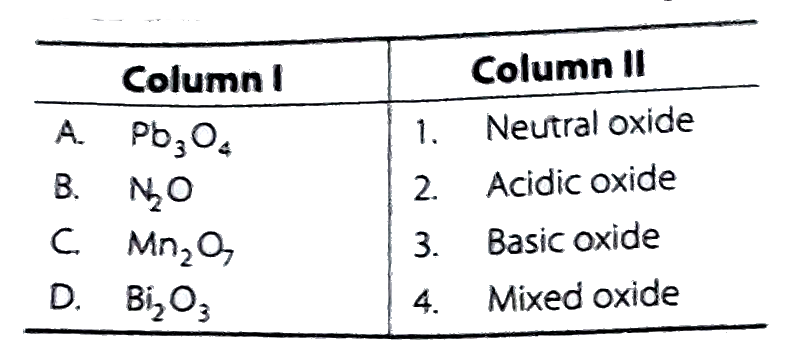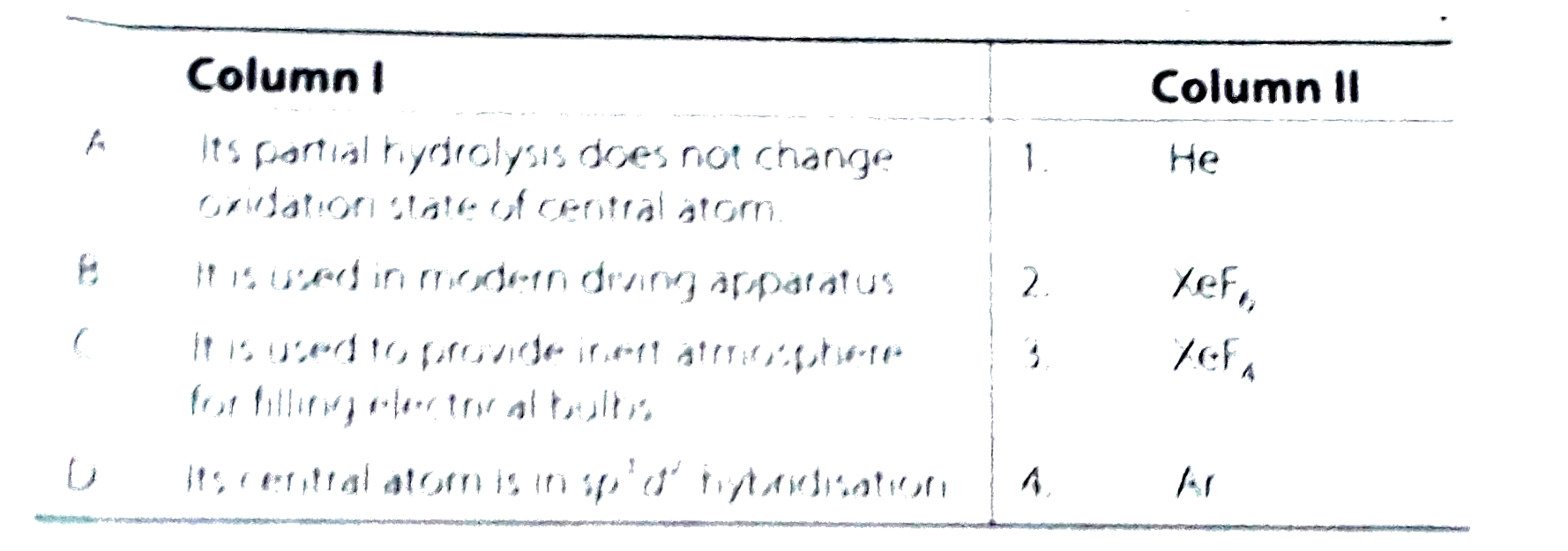Complete Solutions to P-Block Elements of chapter P-BLOCK ELEMENTS of Class 12 book with complete answers and questions
| Class 12 | CHEMISTRY |
| Chapter | P-BLOCK ELEMENTS |
| NCERT EXEMPLAR | P-Block Elements |
| Number Of Questions | 72 |
| Academic Year | 2023-24 |
On addition of conc. `H_(2)SO_(4)` to a chloride salt, colourless fumes are evolved but in case of iodide salt, violet fumes come out. This is because
02:08View SolutionIn qualitative analysis when `H_(2)S` is passed through an aqueous solution of salt acidified with dil. HCl, a black precipitate is obtained. On boiling the precipitate with dil. `HNO_(3)`, it forms a solution of blue colour. Addition of excess of aqueous solution of ammonia to this solution gives
03:00View SolutionIn a cyclotrimetaphosphoric acid molecule, how many single and double bonds are present ?
02:15View SolutionWhich of the following elements can be involved in `ppi-dpi` bonding?
02:13View SolutionWhich of the following pairs of ions are isoelectronic and also isostructural ?
02:04View SolutionAffinity for hydrogen decreases in the group from fluorine to iodine. Which of the halogen acids should have highest bond dissociation enthalpy ?
01:57View SolutionBond dissociation enthalpy of E-H (E=element) bond is given below.

Which of the following compounds will act as strongest reducing agent?02:04View SolutionOn heating with concentrated `NaOH` solution in an inert atmosphere of `CO_(2)`, white phosphorus gives a gas. Which of the following statement is incorrect about the gas?
03:51View SolutionWhich of the following acids forms three series of salts?
01:17View SolutionStrong reducing behaviour of `H_(3)PO_(2)` is due to
01:54View SolutionOn heating lead nitrate forms oxides of nitrogen and lead. The oxides formed are :
01:31View SolutionWhich of the following elements does not show allotropy ?
02:31View SolutionThe maximum covalency of nitrogen is
01:31View SolutionWhich of the following statements is wrong ?
05:01View SolutionA brown ring is formed in the ring test for `NO_(3)^(-)` ion. It is due to the formation of
02:11View SolutionElements of group 15 form compounds in `+5` oxidatin state. However, bismuth forms only one well characterised compound in `+5` oxidation state. The compound is
02:15View SolutionOn heating ammonium dichromate and barium azide separately we get
01:41View SolutionIn the preparation of `HNO_(3)`, we get NO gas by catalytic oxidation of ammonia . The moles of No produced by the oxidation of two moles of `NH_(3)` will be ……… .
02:12View SolutionThe oxidation state of central atom in the anion of compound `NaH_(2)PO_(2)` will be . . . . . . . . .
01:37View SolutionWhich of the following is not tetrahedral in shape ?
01:34View SolutionWhich of the following are peroxoacids of sulphur ?
01:44View SolutionHot conc. `H_(2)SO_(4)` acts as molderately strong oxidising agent It oxidises both metals and non - metals. Which of the following element is oxidised by conc. `H_(2)SO_(4)` into two gaseous products. ?
02:49View SolutionA black compound of manganese reacts with a halogen acid to give greenish yellow gas. When excess of this gas reacts with `NH_(3) an unstable trihalide is formed. In this process the oxidation state of nitrogen changes from . . . . . . . . . .
02:31View SolutionIn the preparation of compounds of Xe, Bartlett has taken `O_(2)^(+)Pt F_(6)^(-)` as a base compound. This is becase
01:14View SolutionIn solid state, `PCl_(5)` is a……..
02:02View SolutionReduction potentials of some ions are given below. Arrange them in decreasing order of oxidising power.
 02:34View Solution
02:34View SolutionWhich of the following is isoelectronic pair ?
01:55View SolutionIf chlorine gas is passed through hot `NaOH` solution, two changes are observed in the oxidation number of chlorine during the reaction . These are . . . . . . . . And . . . . . . . . .
02:59View SolutionWhich of the following options are not accordance with the property mentioned against them?
(a) `F_(2)gtCl_(2)gtBr_(2)gtI_(2)` Oxodising power
(b) `MIgtMBrgtMClgtMF` Ionic character of metal halide
(c ) `F_(2)gtCl_(2)gtBr_(2)gtI_(2)` Bond dissociation enthalphy
(d) `HIltHBrltHClltHF` Hydrogen - halogen bond strength05:07View SolutionWhich of the following is correct for `P_(4)` molecule of white phosphorus ?
02:01View SolutionWhich of the following statements are correct?
I. Among halogens, radius ratio between iodine and fluorine is maximum.
II. Leaving F-F bond, all halogens have weaker X-X bond than X-X' bond in interhalogens.
III. Among interhalogen compounds, maximum number of atoms are present in iodine fluoride.
IV. Interhalogen compounds are more reactive than halogen compounds.
The correct option is02:37View SolutionWhich of the following statements are correct for `SO_(2)` gas?
(a) It acts as bleaching agent in moist conditions.
(b) Its molecule has linear geometry.
(c ) Its dilute solution is used as disinfectant.
(d) It can be prepared by the reaction of dilute `H_(2)SO_(4)` with metal sulphide.03:50View SolutionWhich of the following statements are correct ?
(a) All the three N___O bond lengths in `HNO_(3)` are equal.
(b) All P___Cl bond lengths in `PCl_(5)` molecule in gaseous state are equal
(c ) `P_(4)` molecule in white phosphrus have angular strain therefore white phosphorus is very reactive
(d) `PCl_(5)` is ionic in solid state in which cation is tetrahedral and anion is octahedral . And anion is octahedral.02:56View SolutionWhich of the following orders are correct as per the properties mentioned against ?
(a) `As_(2)O_(3)ltSiO_(2)ltP_(2)O_(3)SO_(2)` Acid strength.
(b) `AsH_(3)ltPH_(3)ltNH_(3)` Enthalpy of vaporisation.
(c )`SltOltClltF` More negative electron gain enthalphy.
(d) `H_(2)OgtH_(2)SgtH_(2)SegtH_(2)Te` Thermal stability.02:49View SolutionWhich of the following statements are correct?
(a) S___S bond is present in `H_(2)S_(2)O_(6)`
(b) In peroxosulphuric acid `(H_(2)SO_(5))` sulphur is in + 6 oxidation steta
(c )` Iron powder along with `Al_(2)O_(3) and K_(2)O` is used as a catalyst in the preparation of `NH_(3)` by Haber's process
(d) Change in enthalpy is positive for the preparation of `SO_(3)` by catalytic oxidation of `SO_(2)`05:52View SolutionIn which of the following reactions conc. `H_(2)SO_(4)` is used as an oxidising reagent?
03:35View SolutionWhich of the following statements are true?
(a) Only type of interactions between particles of nobel gases are due to weak dispersion forces.
(b) Ionisation enthalphy of molecular oxygen is very close that of xenon.
(c ) Hydrolysis of `XeF_(6)` is a redox reaction.
(d) Xenon fluorides are not reactive.02:52View SolutionIn the preparation of `H_(2)SO_(4)` by Contact process, why is `SO_(3)` not absorbed directly in water to form `H_(2)SO_(4)` ?
02:41View SolutionWrite a balanced chemical equation for the reaction showing catalytic oxidation of `NH_(3)` by atmospheric oxygen.
01:15View SolutionWrite the structure of pyrophosphoric acid.
01:01View Solution`PH_(3)` forms bubbles when passed slowly in water but `NH_(3)` dissolves. Explain why ? In `PCl_(5)` Phosphorus is in `sp^(3)`d hybridised state but all its five bonds are not equivalent. Justify your answer with reason.
02:30View SolutionIn `PCl_(5)` phosphorus is in `sp^(3)` d hybridised state but all its five bonds are not equivalent. Justify your answer with reason.
02:58View SolutionWhy is nitric oxide paramagnetic in gaseous state but the solid obtained on cooling it is diamagnetic ?
02:18View SolutionGive one reason to explain why `ClF_(3)` exists but `FCl_(3)` does not exist?
02:11View SolutionOut of `H_(2)O` which one has higher bond angle and why?
03:29View Solution`SF_(6)` is known but `SC_(6)` is not. Why?
02:20View SolutionOn reaction with `Cl_(2)` phosphorus forms two types of halides 'A' and 'B'.
Halide 'A' is yellowish- white powder but halide 'B' is colourless oily liquid.
Identify A and B and write the formulae of their hydrolysis products.03:17View SolutionIn the ring test of `NO_(3)^(-)` ion, `Fe^(2+)` ion reduces nitrate ion to nitric oxide, which combines with `Fe^(2+)` (aq) ion to form brown complex .
Write the reactions involved in the formation of brown ring.02:49View SolutionExplain why the stability of oxoacids of chlorine increases in the order given below.
`HClOltHClO_(2)ltHClO_(3)lt HClO_(4)`03:31View SolutionExplain why ozone is thermodynamically less stable then oxygen ?
02:03View Solution`P_(4)O_(6)` reacts with water according to equation `P_(4)O_(6)to4H_(3)PO_(3)`.
Calculate the volume of `0.1MNaOH` solution required to neutralise the acid formed by dissolving 1.1g of `P_(4)O_(6)` in `H_(2)O`.06:53View SolutionWhite phosphorus reacts with chlorine and the product hydrolyses in the presence of water. Calculate the mass of HCl obtained by the hydrolysis of the product formed by the reaction of 62 g of white phosphorus with chlorine in the presence of water.
05:43View SolutionName three oxoacids of nitrogen. Write the disproportionation reaction of that oxoacid of nitrogen is in +3 oxidation state.
02:11View SolutionNitric acid forms an oxide of nitrogen on reaction with `P_(4)O_(10)`. Write the reaction involved . Also write the resonating structures of the oxide of nitrogen formed.
02:30View Solution(i) White phosphorus (ii) red phosphorus and (iii) black phosphorus. Write the difference between white red and black phosphorus on the basis of their structure and reactivity.
Phosphorus has three allotropic forms __05:03View SolutionGiven an example to show the effect of concentration of nitric acid on the formation of oxidation product.
03:11View Solution`PCl_(5)` reacts with finely divided silver on heating and a white silver salt is obtained , which dissolves on adding excess aqueous `NH_(3)` solution. Write the reactions involved to explain what happens.
03:18View SolutionPhosphorus forms a number of oxoacids. Out of these oxoacids, phosphinic acid has strong reducing property. Write its structure and also write a reaction its reducing behaviour.
03:21View SolutionMatch the compounds given in Column I with the hybridisation and shape given in Column II and mark the correct option.
 03:57View Solution
03:57View SolutionMatch the formulas of oxides given in Column I with the type of oxide given in Column II and mark the correct option.
 02:27View Solution
02:27View SolutionMatch the items of Columns I and II and mark the correct option.
 02:34View Solution
02:34View SolutionMatch the species given in Column I with the shape given in Column II and mark the correct option.
 03:11View Solution
03:11View SolutionMatch the items of Columns I and II and mark the correct option.
 02:33View Solution
02:33View SolutionAssertion (A) `N_(2)` is less reactive than `P_(4)`.
Reason (R ) Nitrogen has more electron gain enthalpy then phosphorus.04:14View SolutionAssertion (A) `HNO_(3)` makes iron passive.
Reason (R ) `HNO_(3)` forms a protective layer of ferric nitrate on the surface of iron.02:37View SolutionAssertion (A) HI cannot be prepared by the reaction of KI with concentrated `H_(2)SO_(4)`.
Reason (R ) HI has lowest H___X bond strenth among halogen acids.02:35View SolutionAssertion (A) Both rhombic and monoclinic sulphur exist as `S_(8)` but oxygen exists as `O_(2)`.
Reason (R ) Oxygen forms `ppi-ppi` multiple bond due to small size and small bond length but `ppi-ppi` bonding is not possoble is not possible in sulphur.03:16View SolutionAssertion (A) `NaCl` reacts with concentrated `H_(2)SO_(4)` to give colourless fumes with pungent smell. But on adding `MnO_(2)` the fumes become greenish yellow.
Reason (R ) `MnO_(2)` oxidises HCl to chlorine gas which is greensh yellow.02:46View SolutionAssertion:- `SF_(6)` cannot be hydrolysed but `SF_(4)` can be.
Reason:- Six F atoms in `SF_(6)` prevent the attack of `H_(2)O` on sulphur atom of `SF_(6)`02:28View SolutionAn amorphous solid A burns in air to form a gas B which turns lime water milky. The gas is also produced as a by - product during roasting of sulphide ore. This gas decolourises acidified aqueous `KMnO_(4)` solution and reduces `Fe^(3+)` to `Fe^(2+)` . Identify the solid A and the gas B and write the reactions involved.
05:13View SolutionOn heating lead (II) nitrate gives a brown gas " A". The gas " A" on cooling changes to colourless solid "B" . Solid B on heating with NO changes to a blue solid 'C . Identify ' A', 'B' and' C and also write reactions involved and draw the structures of 'B' and 'C' .
05:05View SolutionOn heating compound (A) gives a gas (B) which is a constituent of air.
This gas when treated with 3 moles of hydrogen `(H_(2))` in the presence of a catalyat gives another gas (C ) which is basic in nature. Gas C on further oxidation in moist condition gives a compound (D) which is a part of acid rain. Identify compounds (A) to (D) and also give necessary equations of all the steps involved .05:04View Solution
P-Block Elements questions and complete solutions for chapter P-BLOCK ELEMENTS of CHEMISTRY of Class 12
